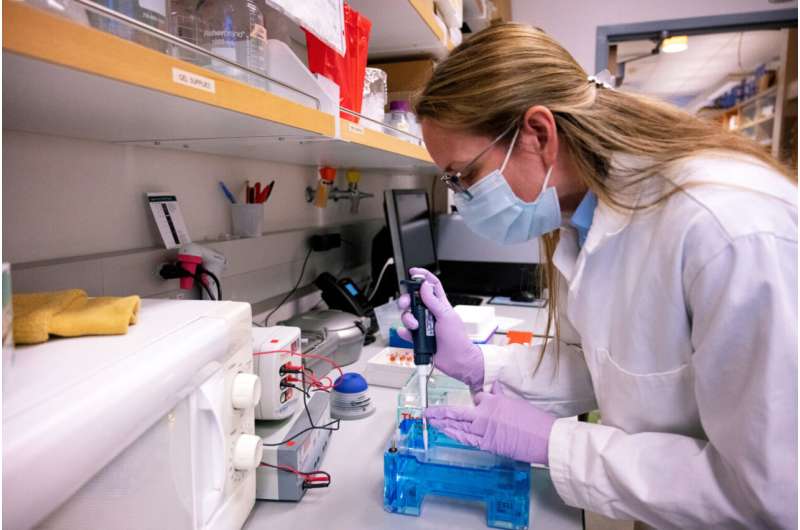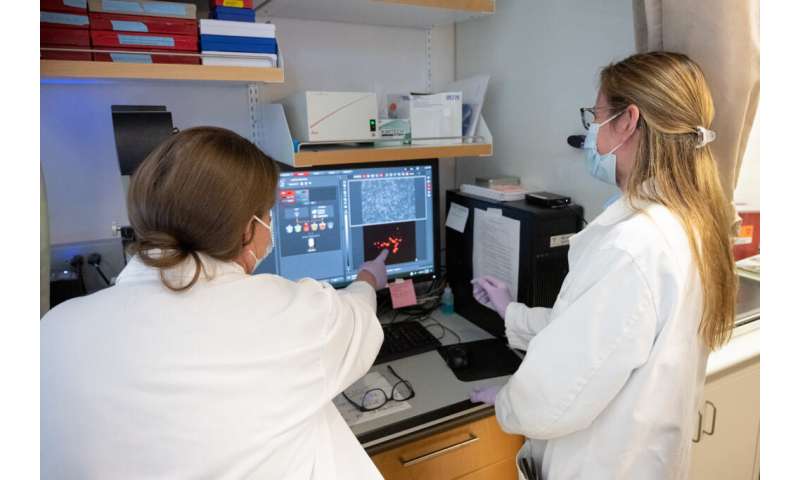
When Dr. Amy MacNeill was in graduate school, the grandniece of one of her colleagues was diagnosed with rhabdomyosarcoma, a type of cancer that affects muscle tissue.
Of the sarcomas that affect children and adolescents, rhabdomyosarcoma is the most common. Treatment is challenging because the cancer metastasizes in 60% of those who develop it. The tumors are complicated to remove completely and attempts to surgically excise them from the muscle often lead to amputation.
Witnessing the family’s battle with the disease inspired MacNeill to focus her research on developing a treatment for rhabdomyosarcoma. That was 15 years ago, and she’s still at it.
“My research focus came from the need and desire of a family to help their kid,” said MacNeill, who is a veterinary pathologist in the Department of Microbiology, Immunology, and Pathology.
Killing cancer with viruses
MacNeill’s work is part of a growing subfield of cancer therapy called oncolytic virus therapy, which involves using genetically modified viruses to not only kill cancer cells, but also trigger an additional immune response from the body against those same cancer cells.
Working with myxoma, a poxvirus that, in its wild type—or unmodified form—causes infection in rabbits, MacNeill worked her way through several stages of the research process to create a cancer vaccine for soft tissue sarcomas like rhabdomyosarcoma.
She started with the basics.
“The first thing we did was see if the modified virus would even replicate in the tumor cells we were interested in curing,” MacNeill said.
It did.
From there, the research process continued to evolve, both within MacNeill’s lab and in the broader field of oncolytic virus therapy. Major developments in cancer immunology demonstrated that cancer cells can block the body’s immune response. But researchers discovered some viruses can be modified in a way that is safe for normal cells, deadly to cancer cells, and enhances an immune response against the cancer cells that resists future tumor growth, too.
These ongoing research efforts demonstrate the potential for an effective cancer treatment option in addition to chemotherapy, surgery, and radiation: immunotherapy.
“We’ve realized how important the immune response is against cancer. We know by infecting cancer with a virus that’s safe for healthy cells, the immune system recognizes the cancer cells as abnormal now,” MacNeill said. “We’re starting to combine oncolytic virus therapy with immunotherapy to drive a strong immune response against cancer cells.”

Advancements like this one kept MacNeill’s work moving, answering research questions along the way. She explored whether the viral therapy could stimulate a T-cell response, cemented a focus on soft tissue sarcomas, tried different immunostimulatory molecules, and started looking at whether this approach could help dogs with cancer.
“It was lots of little things over time that affected my work,” MacNeill said. “Another major development we’ve had here at CSU is being able to use these therapies as you really would in a cancer patient—in canine patients.”
Modifying myxoma
With the help of Laura Ashton, her research associate and lab manager, MacNeill’s modified myxoma viral therapy shrinks and eliminates a tumor once the bulk of it is surgically removed.
“What seems to be the best way to do it is to excise the tumor, then if the tumor doesn’t come out cleanly—they think there might be tumor pieces left—inject the viral therapy around that surgical site to hopefully clear off cells they couldn’t get surgically,” Ashton said.
A few veterinary clinical trials have shown promise for the vaccine candidate and that it’s safe for use in dogs, with hopefully more trials on the horizon to further prove its effectiveness. As a veterinarian, MacNeill sees the potential of immunotherapy for canine cancer, as well as a need for it in human medicine.
Curing canine cancer, first
Just like the field of oncolytic viral therapy, recognition of dogs as a good model for human diseases like cancer is relatively new. And researching the effectiveness of viral therapies for canine cancer is not just a means to an end because it benefits both dogs and people.
“Cancer is a big reason why people lose their animals,” Ashton said. “Everybody wants to save their pet and make sure they live a little longer.”
Cancer or no cancer, dogs don’t live as long as people. Getting a few extra years of life from a beloved canine companion as a result of a successful viral therapy amounts to a lot in dog years, yet still a shorter time to wait than it would be for humans. In other words, with the help of canine research, we can learn if these types of cancer treatments are working, faster.
“I think it’s just really good to have another tool in the toolbox against cancer. It affects a lot of people,” Ashton said. “If this therapy works really well in animals, maybe someone else can take it up and try it for humans.”
MacNeill is still years away from turning her viral therapy into a commercially available pharmaceutical for veterinary use, but she continues to take steps toward that goal. Next stop after that would be developing a similar treatment for humans, too.
“If you asked me 15 years ago if this was where I’d be I would have had no clue,” MacNeill said. “I can’t imagine anyone on the planet who hasn’t been affected by cancer. If I can contribute even a little bit to make it better in the future, that would be great.”
Jessica Cox, Colorado State University

